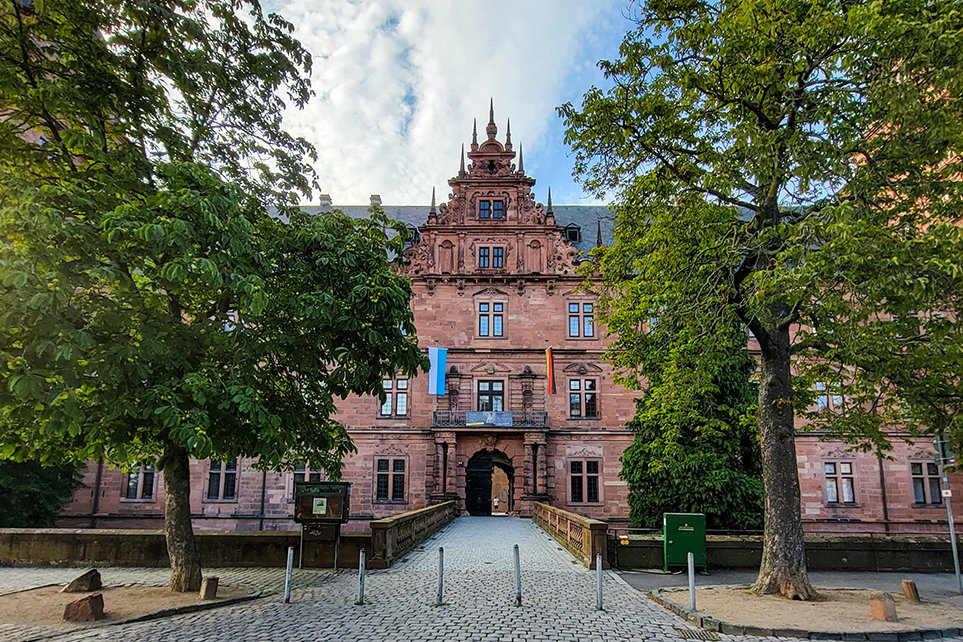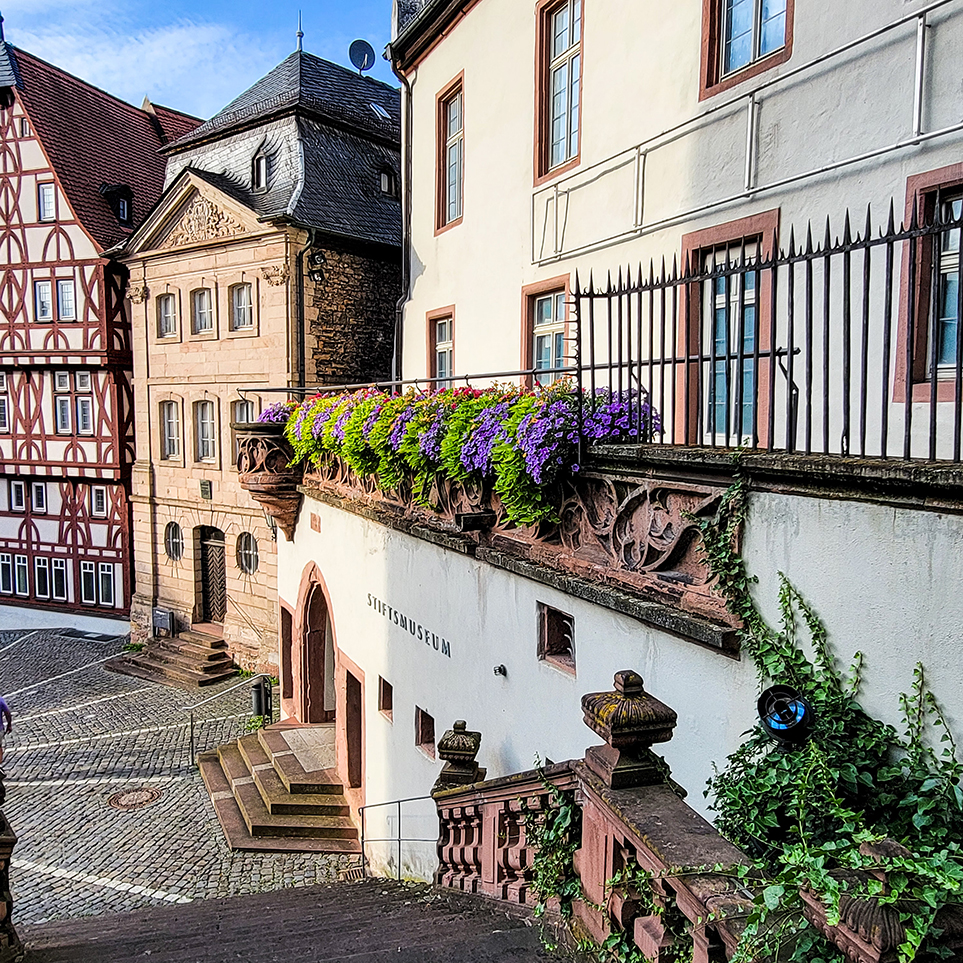
While in Frankfurt am Main, Germany, we took an excursion 30 minutes outside of the city to the charming Bavarian town of Aschaffenburg. Filled with eclectic architecture, a massive castle, churches, and parks, this town is one you should not overlook!
Things to Do in Aschaffenburg
Surprisingly there are several things to unveil in Aschaffenburg to keep you busy for a day or two. Here’s a list of the main attractions and a few gems you should check out while there.
Johannisburg Palace
Step back in time at Aschaffenburg’s giant castle! Johannisburg Palace. It was built between 1605 and 1614 out of the rich red sandstone and is considered Germany’s most significant Renaissance structure.
Today, it houses various art collections, era-decorated residential rooms, and a chapel that is open to the public. Another impressive collection is one of the world’s most compelling architectural models made from cork can be seen here, such as the Roman Colosseum and other famous buildings.
You can learn more about Johannisburg Palace at the official website.


The Palace Park
After exploring Johannisburg Palace, mosey towards the river where various paths and green space will greet you.
This green space is the Palace Park, which meanders all the way to the Pompejanum. The well-manicured landscape, designed with trails, bridges, and crisscross paths, makes for an enjoyable journey.

The Pompejanum
As you continue your walk along the river, you’ll find signs that point you to the Pompejanum.
This elegant Roman villa was built for King Ludwig I in the 1840s. The brightly colored building was inspired by the villas excavated in Pompeii.
The building was severely damaged during World War II but has been restored. Today, it houses artwork and various exhibitions.
The grounds around the building are well-kept, featuring a Mediterranean-style garden designed in the mid-19th century.
- Hours: March – October 9:00 – 18:00, October – March 10:00 – 16:00
- Admission: 6 EURO

Basilica of St. Peter and Alexander
Trekking through Aschaffenburg, we came upon the Basilica of St. Peter and Alexander located near the Rathaus.
The construction of this oldest church in Aschaffenburg began in 975. The gothic style can be seen in much of the architecture. Several centuries later (12th -13th), new construction changed some of the appearances to Roman-style architecture. It is the only church in the world that is dedicated to both saints, Peter, and Alexander.
Inside, the abbey is decorated with art of historical significance, such as the 10th-century Crucifix of Otto and the Lamentation of Christ. Treasury of St. Peter and St. Alexander is one of the most impressive collections of medieval church treasures in Germany.


Explore History in the Stiftsmuseum
Located under St. Peter and Alexander Church is the Stiftsmuseum, known as a “medieval treasure chamber,” a Middle Ages era museum.
It is considered a Treasury and serves as a time capsule into life in Medieval times. Artifacts, goldsmiths’ works, and examples of manuscripts, textiles, and paintings are on display.
- Hours: Closed Monday, Tuesday – Sunday 11:00 – 17:00
- Admission: 2.50 EURO
Theatreplatz Square
Tucked away near the Basilica is Theaterplatz Square. Nearby is the Stadttheater, built in 1811. It was almost destroyed during WWII; however, it has been restored and still hosts various performances.
Something interesting to see in Theatreplatz Square is the sundial, one of Europe’s largest.
The square is lined with lush landscape giving it the Bavarian charm.
- If you are interested in attending a performance at the Stadttheater, please check their website for more information.

Aschaffenburg Old Town
As you stroll from the Johannisburg Palace towards the Basilica, narrow cobblestone streets lined with decorated houses and in their classic timber style is what remains of Aschaffenburg Old Town. The Old Town of Aschaffenburg is captivating!
We wandered in and out of the side streets, admiring the architecture and window shopping. The Bavarian-style buildings make for a delightful stroll while visiting Aschaffenburg.
Aside from sights and attractions, lots of little shops and restaurants along the way should you desire a beer or a bite to eat.

Our Lady
Our Lady is the oldest parish church in Aschaffenburg, inaugurated in 1775. On one wall of the early gothic tower, there is a tympanum from the 12th century, representing the Mother of God between John and Catherine.
The main façade is adorned in the gables by several family’s coat of arms, such as the builder Christian Stadelmann and the elector and archbishop Emmerich Joseph von Beidbach zu Burresheim.
I noticed the fascinating ceiling, repainted in 1967 by the Munich artist Professor Hermann Kasper. Take your time to admire the details of his work.


Museum of Jewish History and Culture
Once a former Rabbi’s home, the Museum of Jewish History and Culture has become filled with intriguing documents of the Jewish community that once called Aschaffenburg home.
- If you want to visit the Museum of Jewish History and Culture, visit the website for hours. Admission is free.

Schöntal Park + Beguine Abbey
Away from the hustle and bustle of the city, In the middle of Aschaffenburg, is the heavenly Schöntal Park.
Relish in the tranquil ponds, large trees, and the fresh air. The English-style gardens have inspired the landscape.
Within the park is the former Beguine Monastery, perched in the middle of a small lake. Something about the tranquility of the lake feels romantic, strolling around the green trees while examining the ruins.

Schönbusch Park and Palace
As we began our journey back to Frankfurt am Main, we stopped at Schönbusch Park, a short 10-minute drive outside Aschaffenburg.
Originally designed as a hunting park for the elector, but later was changed into an Augustan-Serpentine style park in 1775– with lakes, watercourses, a shepherd’s cottage, hills, and serpentine walking trails.
The centerpiece of Schönbusch Park is the pavilion “castle” or Schloss, as they call it in Germany. This home never served a full-time resident but rather a summer home or guesthouse. This 18th-century palace is visibly in the line of sight from the elector’s palace in the center of Aschaffenburg (Johannisburg Palace).


The park features a wide variety of plants and extensive wooded areas. You can canoe in the pond or sit to watch the ducks play in the water. Within the woods are historic-looking buildings that serve as a decoration element, such as the Lookout Tower and the Red Bridge.
- Before you leave, stop at the beer garden for an afternoon beer and pretzel.
- Admission: It is free to enter the park.
- Hours: The Schönbusch Palace is open from April 30 – October, from 9 am to 5 pm. The admission into the palace is 3.60 EURO.

This lovely town of Aschaffenburg is riveted with things to see while in Germany. Don’t miss visiting Aschaffenburg as you may be surprised at the interesting history it has to share.
Enjoy your travels! Please read my blogs about other exciting places around the world at Traveling Lens Photography.
If you want to read more follow me on Facebook, Instagram, or Pinterest as I share my journey.
Happy Travels!







Aschaffenburg
hallo. super-tolelr bericht über meine heimatstadt. ich bin gebohren und aufgewachsen in aschaffenburg. grundschule, erste liebe, etc. alles in aschaffenburg. ich denke mal, ich kenn mich ganz gut auch in meiner base aus. kurz um: toller und feiner artikel. hat echt spass gemacht beim lesen. würde ich nicht schon hier wohnen, würde ich nach diesem artikel sofort nach aschaffenburg umziehen. danke & LG
Lanell Rachid
Thank you! We truly enjoyed our visit and look forward to traveling here again. Lanell